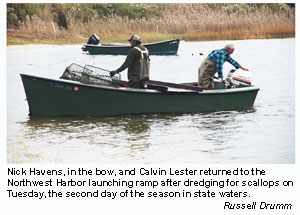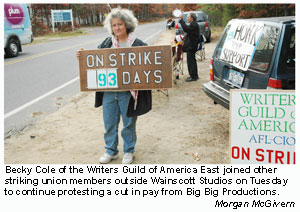SOUTHAMPTON: Shinnecock Nation Is Recognized, Federal ruling could be a step forward
SOUTHAMPTON: Shinnecock Nation Is Recognized, Federal ruling could be a step forward
Afer a 27-year wait, the Shinnecock Indian Nation received federal recognition as a tribe on Monday afternoon from United States District Court Judge Thomas C. Platt. The nation filed an application for recognition with the Bureau of Indian Affairs in 1978.
In a statement, the Shinnecock Indian Nation Tribal Board of Trustees said, "the federal court issued a historic ruling acknowledging the Shinnecock Indian Nation as an Indian tribe . . . and ruling that the Shinnecocks clearly meet the criteria for tribal status." The trustees are expected to hold a press conference soon.
Whether such judicial recognition confers the same rights as recognition by the Bureau of Indian Affairs is under debate. Roberta Hunter, a lawyer who lives on the reservation, said it did not, but added that the Shinnecocks would continue with the B.I.A. process hoping that the bureau might move faster than it has in the past. "We'll have to stay focused" while moving forward with the petition, she said.
Judge Platt's decision does not automatically place the tribe on the Bureau of Indian Affairs list of federally recognized tribes, but does give them the right, in his opinion, to develop their properties without approval by the United States.
Nonetheless, the judge declined to offer a summary judgment on whether the tribe could develop its Westwoods property in Hampton Bays as a casino. That issue will still have to be resolved at a trial.
Politicians across the board continue to oppose a casino at the site.
Michael Cohen, an attorney at Nixon Peabody who is representing South-ampton Town in its litigation against both the casino and the land claim filed by the Shinnecocks against the town, said that it continues to be the town's position that the Westwoods property does not qualify as "Indian country" under the law, and that "town zoning law applies, local law applies, and state anti-gaming law applies." The land is currently zoned for two-acre residential use.
As to Judge Platt's recognition, Mr. Cohen said, "it's a long way from recognition to casino gaming assuming that the recognition that Judge Platt seems to have granted is in any way binding on the federal government." As long as the Shinnecocks are not on the B.I.A. list they cannot "under any circumstances be allowed to game."
Tom Schlosser, a partner in the firm Morisset, Schlosser, Jozwiak, and McGaw, which specializes in federal Indian law, said that "any determination of federal recognition isn't going to mean much until federal agencies accept it."
Mr. Platt quoted the Shinnecock's brief in the case, which itself cited numerous precedents for judicial decision. "Federal courts have held that to prove tribal status . . . an Indian group must show that it is a 'body of Indians of the same or a similar race, united in a community under one leadership or government, and inhabiting a particular though sometimes ill-defined territory.' "
Mr. Platt said the cases cited "establish a federal common law standard for determining tribal existence that the Shinnecock Indian Nation plainly satisfies."
In the cases the Shinnecocks are party to, none appears to involve a feder-
al agency. If federal agencies are not named in an action, Mr. Schlosser said they "won't consider themselves bound" by a decision in those cases.
Mr. Schlosser said a 1975 case, in which the Passamaquoddy Tribe successfully sued the Secretary of the Interior for refusing to recognize it, could be a relevant model for further action by the Shinnecocks, if there is resistance to add them to the federal register.
In the case of the Passamaquoddys, Mr. Schlosser said their establishment of federal tribal rights also led to the settlement of their main land claim. The Shinnecocks filed suit this past summer claiming rights to portions of Southampton Town.
The Shinnecock trustees said given Mr. Platt's decision, "we believe it's time for the State of New York and the Town of Southampton to stop fighting the Nation and work with us to reach a comprehensive and just solution to our claims."
Mr. Cohen described that land claim case as "in the earliest stages." He said he did not believe the judge's decision would affect the defenses that the town planned to use in the case. He did agree that "a land claim under the [non-intercourse act] can be brought by an Indian tribe that is recognized even if it has not been recognized by the B.I.A. but there are a host of requirements for any tribe to make out a land claim." Mr. Cohen added that there were land claim cases that have gone on for decades in New York State.
There are other issues complicating the Westwoods casino matter. In the Supreme Court decision City of Sherrill v. Oneida Indian Nation, the court said that tribes could not extend the rights associated with its reservation to newly acquired land. Mr. Platt said in his decision that Westwoods, if proven to be acquired by adverse possession, "must be considered in its present independent status."
Westwoods is not contiguous to the area historically recognized as the Shinnecock Reservation. The Shinnecocks' rights to it stem from the need for lumber not present on the reservation for firewood and fencing. Whether the Shinnecocks' rights to the land are unbroken or whether their rights to it were recognized after legal title was held by someone else in Colonial times could make a difference in what right they have to develop a casino there.
The nature of the Shinnecocks' title has been questioned by Southampton Town's legal representatives, even though the land has not been taxed by the town or the state since 1850.
Ms. Hunter said it "felt great" that the "federal judiciary have issued a decision of this kind acknowledging our existence." As an attorney who has worked since the 1970s on the issue of federal recognition, she said the decision from a federal judge in the Second Circuit had a "great weight to it."
Personally, she said it was a great legacy for the children on the reservation. As they grew up, her own three children watched Ms. Hunter in meetings on the matter. The decision will give them "a great sense of their place in the history of the East End of Long Island and the State of New York. It's an unbelievable, emotional experience."
As good as it felt, she pointed out that the nation did not need the decision to feel its own validation. "We're strong in our own self-governing and self-existence . . . it's great to have recognition within that system, but it's not our system."



